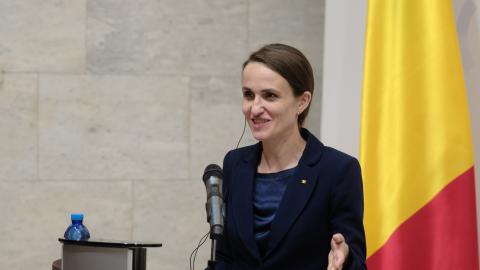The winner: John Maynard Keynes, the advocate of government spending to boost growth. The loser: Angela Merkel, the austere fighter for balanced budgets. Host at the loose fiscal celebration at Harvard University: Larry Summers. Chief mourner at the austerity funeral: Jens Weidman, at the German Federal Bank of which he is the president.
Summers, who was one of President Obama’s treasury secretaries, has long argued that the secular stagnation theory, developed by Keynes acolyte and Harvard professor Alvin Hansen in the 1930s, "offers the most comprehensive account of the situation and the best basis for policy prescriptions." It goes something like this: inadequate demand for goods and services discourages businessmen from investing enough to produce robust economic growth. Only "an expansionary fiscal policy by the U.S. government can help overcome the secular stagnation problem and get growth back on track," says Summers. In short, despite the some $20 trillion in debt and a rising deficit, the government should loosen its purse strings to increase the economy's current feeble growth rate.
This theory, largely discredited when a depression failed to follow the end of World War II, is taking on new life as incoming data seem to confirm the hypothesis. Only 38 percent of the CEOs of America's largest companies expect to raise sluggish business spending in the next six months. Why should they, when retail sales fell in August, with the important auto sector showing weakness, and when the factory sector "remains in an extended period of stagnation," according to Michael Gapen, chief U.S. economist at Barclays.
The next step down the road to looser fiscal policy, broadly, more borrowing and spending by government, came in Jackson Hole a few weeks ago. A long period of zero and in some cases negative interest rates has not produced a flood of investment in factories and other facilities by businessmen. As the Wall Street Journal, commenting on Japan's effort to end decades of stagnation, put it in a page-one article yesterday, "The world's leading experiment in monetary easing is floundering…. It is part of a larger unease in the central banking world where years of easy monetary policy have failed to achieve goals in Europe as well as in Japan, and the U.S. Federal Reserve is struggling with how and when to follow through on a long-advertised tightening".
Businessmen prefer to use their free-to-cheap money to buy existing assets, purchases that do not contribute to growth. Please, sirs, can we have some help, ask these supposedly all-powerful bankers.
Next in line to call for more expansionary fiscal policy were the leaders of the industrialized nations, gathered at their annual summit in Hangzhou, China. In their end-of-gabfest communique, the G20 leaders announced that they "are determined … to usher in a new era of global growth … catalyze new drivers of growth … unleash mid- to long-term growth potential … identify new growth engines…". Translation: we will step up government spending.
There might be some room for the private sector, but Summers, their intellectual leader, points out that the return on public sector investment is so high (20 percent) and government borrowing costs so low, that government will be the main source of investment funds to repair run-down infrastructure. Of course, such borrowing might not be necessary in the long run since, says Summers, "There is a compelling case that infrastructure investments pay for themselves by expanding the economy and increasing the tax base."
Candidates for office generally do not need much urging to spend taxpayer money. Hillary Clinton has announced that if elected she will launch a five-year, $275 billion infrastructure spending program, including $25 billion in seed money to create a national infrastructure bank. It would guarantee loans to state and local governments and the private sector, bringing total spending to $500 billion. Donald Trump considers that to be what in Las Vegas would be called "chump change." His infrastructure plan, which also includes some sort of infrastructure bank, would cost between $800 billion and $1 trillion, the low end of the $1 trillion-to-$2 trillion that Summers told a Democratic Party roundtable is needed.
There's more. Clinton is proposing a host of entitlement programs, including financial aid to college students, expanded health care, early childhood education and family leave programs, to be paid for by raising taxes on the wealthiest 1 percent of Americans. Trump is having no part of tax increases, promising $4.4 trillion in tax cuts, with the business tax rate coming down from 35 percent to 15 percent. And spending is to go up: Spurred on by his daughter, Ivanka, Trump proposes to revise the tax code to enable families to cope with the high cost of child care and a generous maternity leave program.
Trump's advisers agree with Summers that faster growth will return to the Treasury some of the funds lost to tax cuts. They put that return at 40 percent of the funds initially lost. The rest will come from reducing regulation and the usual fudge, reducing waste. In his speech to the Economic Club of New York on Thursday, Trump did what his critics have been contending he could not do: He laid out what I would call a plan that is evolving towards coherence to make America great again. As the highly regarded Douglas Holtz-Eakin, a Republican adviser points out, "It doesn't add up". Perhaps not. But adopts static scoring, which assumes that taxes affect behavior, anathema to Clinton and Democrats, includes an effort to take account of the growth-stifling effects of regulation, and calls for annual 1 percent cuts in non-defense spending.
But it is a plan that is a thumb-in-the-eye to establishment Republicans, for whom deficit-reduction and smaller government are the holy grails of politics, and for whom Ivanka Trump's plans for maternity leave and child care seem more appropriate to the Clinton agenda of expanding the entitlement state than to the program of a Republican candidate. Pulitzer-Prize-winning columnist Charles Krauthammer lamented on Fox News, "How many Democratic parties does the country need? We already have one. What he is proposing is to out-Democrat the Democrats."
But a President Trump would have to run the gauntlet of the deficit hawks gathered around House Speaker Paul Ryan. Believers in the old-time Republican religion of lower deficits and smaller government, they lie in wait for the new president in their congressional offices, confident that when he, or Clinton, send their proposals for review, the House has the power to pronounce them DOA if the new president fails to negotiate a deal that puts greater weight on old-fashioned fiscal probity, including reining in entitlement spending.
But the times are with the spenders. For one thing, Americans can see crumbling bridges and airports, and whether or not they follow the writings of Larry Summers, know that more infrastructure spending is required as both candidates are contending. They also believe that our current slow growth, although it has begun to produce some increase in real incomes, is not fast enough to enable their children to live better than they are living, a key part of the American dream. All of this adds up to a demand for a Keynesian-style looser fiscal policy, for opening the sluice gates that were closed when the bipartisan sequester dammed up spending. Both candidates are willing to respond, or pander, whichever you prefer, to this popular demand.
Central bankers: help is on the way from fiscal policy, "the most under-appreciated economic development of the year," according to Wall Street Journal economist Greg IP. Whether you will like what you have been wishing for remains to be seen.




















